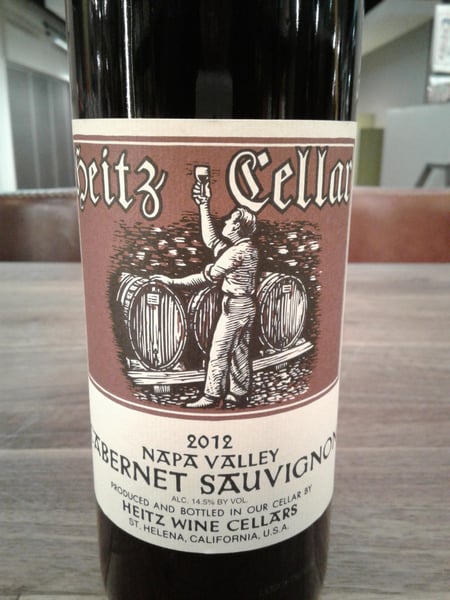There's an old saying, “Never judge a book by its cover.” Is the same true for wine? Aside from avoiding labels with kangaroos and footprints, what should the discerning shopper look for when buying a bottle?
You walk into a store to buy a bottle of wine for a dinner party or to pair with a special meal. Before you step through the door you should already know if you're looking for a red, white, or sparkling. So, from this point forward I'm building off the assumption you have an idea of what you want (if not, just buy the sparkling, it's always welcome at the table and it pairs with everything.
If you're like most Americans, the first thing you look for is the grape variety. Fortunately, American wine producers are aware of this and often display the varietal prominently on the label. Take this bottle of Heitz Cellar, for example. This is a best case scenario for a label. The wine is made with Cabernet Sauvignon grapes, harvested in 2012, from Napa, California, has an alcohol content of 14.5%, and was produced and bottled at the same place (i.e. estate bottled). If I was looking for a full-bodied red, I would know from just looking at the front label, that I had found my match. Easy right? Just wait.

This is perhaps the greatest divide between how Americans and French approach wine and one reason French wine can seem so intimidating. We're missing what we consider to be the most vital piece of information! Fear not, dear reader, I have a solution. To the internet! A Google search brought me a review from a wine seller that seems reliably sourced, it reports the blend to be 65% Grenache, 20% Syrah, and 15% Mourvèdre. Problem solved!
One final note on CdP. This seal on the front of the bottle is not simply an aesthetic choice of the wine producer, it actually indicates the wine passed an additional certification. So, beyond jumping through all the hoops of the French AOC/AOP guidelines, this wine was also certified by another governing board specific to that region. Generally, this is a positive indicator for a good wine.
Is estate bottling important?
I've found more consistent quality from estate bottled wines than from those which buy grapes to produce elsewhere. Xavier CdP is an exception to this rule.
Are review sites trusted sources of information?
Generally, I want my information source to be as close to the producer as possible. For most wines, you can find an info sheet on the vineyard or distributor's website that provides a wealth of information. I had difficulty with Xavier CdP, the distributor had nothing on their site and the producer doesn't have a website. I knew Grenache is typically the dominant grape in CdP and in order to pass certifications only certain grapes would be allowed in the blend. So, the answer I found fits what I expected. However, I initially tried use Vivino, which claimed Sauvignon Blanc was present as well. That seemed suspect, so I looked for another source.
When I selected these two bottles, I wasn't trying to find extremes to demonstrate the spectrum of difficulty one might encounter when looking for wine, but it seems that's what I've done. In most stores, you would never see these two bottles sitting next to one another, they're both part of The Chopping Block's new Reserve List of fine wine. If you haven't been in the store for a while, definitely stop by and check out the new selection. We have Happy Hours every Tuesday at Merchandise Mart from 4-6pm and Thursday at Lincoln Square from 5-7pm.
If you are interested in learning more about the world of wine and food pairing, be sure to download our free guide.
